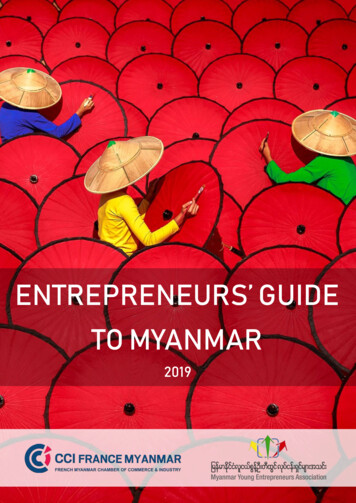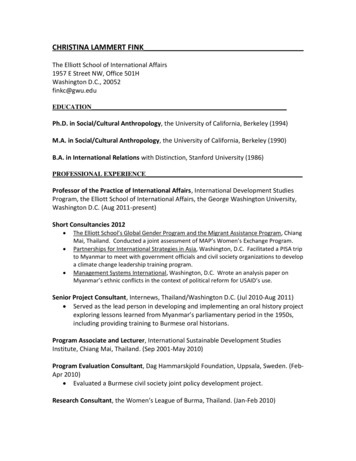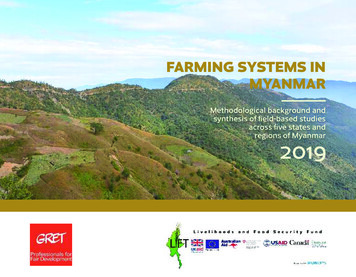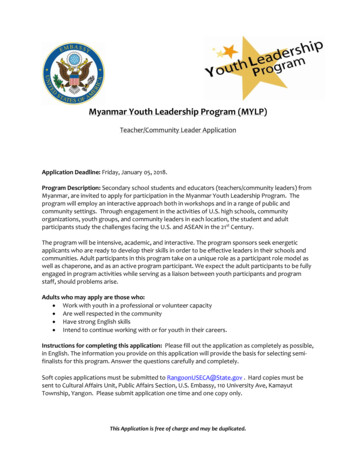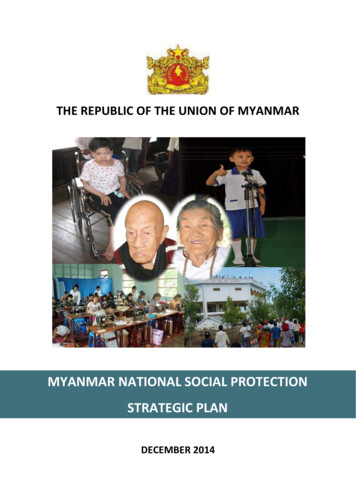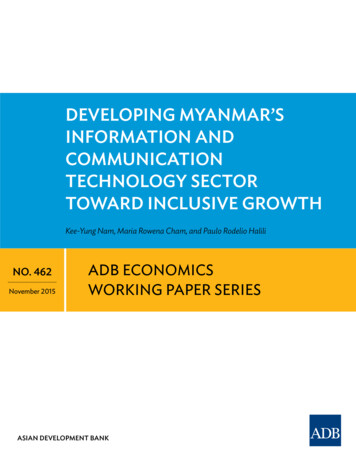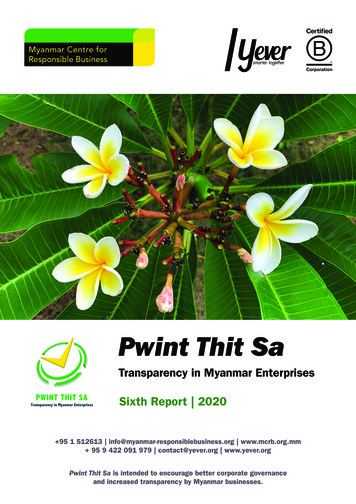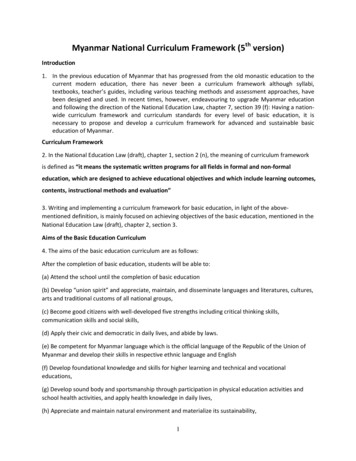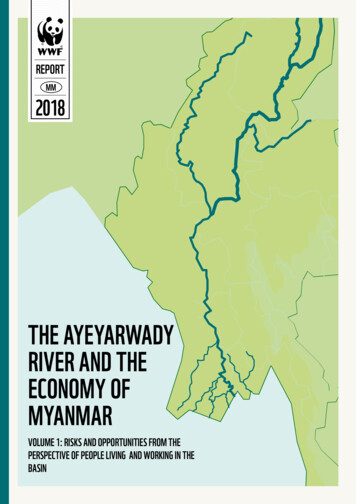![Myanmar 2015-16 Demographic And Health Survey - Key Findings [SR235]](/img/66/sr235.jpg)
Transcription
Myanmar2015-16 Demographic and Health SurveyKey Findings
The 2015-16 Myanmar Demographic and Health Survey (2015-16 MDHS) was implemented by the Ministryof Health and Sports of the Republic of the Union of Myanmar. Funding for the survey was provided by theUnited States Agency for International Development (USAID) and the Three Millennium Development GoalFund (3MDG). ICF provided technical assistance through The DHS Program, which assists countries in thecollection of data to monitor and evaluate population, health, and nutrition programs.Additional information about the 2015-16 MDHS may be obtained from the Ministry of Health and Sports,Building No. 47, Nay Pyi Taw, Myanmar; Telephone: ( ) 95-67-431075; Fax ( ) 95-67-431076; Website: www.mohs.gov.mm.Additional information about The DHS Program may be obtained from ICF, 530 Gaither Road, Suite 500,Rockville, MD 20850, USA; Telephone: 301-407-6500; Fax: 301-407-6501; e-mail: info@DHSprogram.com;Internet: www.DHSprogram.com.Suggested citation:Ministry of Health and Sport (MOHS) and ICF. 2017. 2015-16 MDHS Key Findings. Rockville, Maryland, USA:MOHS and ICF.Cover photographs:Banner: @2015 Dr Htin Aung LattA happy family on Inle Lake in Myanmar: 2005 Eric Thompson, Courtesy of Photoshare.
About the 2015-16 MDHSThe Myanmar Demographic and Health Survey (MDHS) is designed to provide data for monitoring thepopulation and health situation in Myanmar. The 2015-16 MDHS is the first Demographic and Health Surveyconducted in Myanmar, and the objective of the survey was to provide reliable estimates of fertility levels,marriage, fertility preferences, awareness and use of family planning methods, breastfeeding practices,nutrition, maternal and child health and mortality, awareness and behavior regarding HIV/AIDS and othersexually transmitted infections (STIs), and other health-related issues such as smoking and knowledge oftuberculosis that can be used by program managers and policymakers to evaluate and improve existingprograms.Who participated in the survey?A nationally representative sample of 12,885 women and 4,737 men age 15-49 in 12,500 selected householdswere interviewed. This represents a response rate of 96% of women and 91% of men. The sample design forthe 2015-16 MDHS provides estimates at the national and state/regional levels, and for urban and rural areas.2015-16 Myanmar Demographic and Health SurveyPage 1
Characteristics of Households and RespondentsHousehold CompositionHouseholds in Myanmar have an average of 4.2members. Twenty-three percent of households areheaded by a woman. Twenty-nine percent of thehousehold population is under age 15.Water, Sanitation, and ElectricityMore than half (56%) of households in Myanmarhave electricity. Electricity is almost universalin urban households (92%), while only 42% ofhouseholds in rural areas have electricity.Eight in ten households have an improved source ofdrinking water. Access to improved water is better inurban areas (89%) than rural areas (77%). 2007 Kyaw Kyaw Winn, Courtesy of PhotoshareJust under half (48%) of households have animproved sanitation facility. Ten percent have afacility that would be considered improved if it werenot shared. Overall, 42% of households in Myanmarhave an unimproved facility. This includes 11% thathave no facility at all.Ownership of GoodsAlmost three-quarters (73%) of households own amobile phone, while 57% own a television and 34%own a radio. Mobile phones and televisions aremore common in urban households, while radios areslightly more common in rural areas.EducationPercent distribution of women and men age 15-49by highest level of education attended107Half of households in Myanmar own a motorcycle orscooter; 42% have a bicycle; 5% have a car or truck,and 6% own a boat without a motor.3645Education413613Women12MenAmong the women and men age 15-49 interviewedin the MDHS, 13% of women and 12% of men haveno education. While the majority of women and menhave attended primary or secondary school, only10% of women and 7% of men have gone beyondsecondary school.More thansecondarySecondaryPrimaryNo educationAlmost 90% of Myanmar people (85% of women and91% of men) are literate.Page 22015-16 Myanmar Demographic and Health Survey
Fertility and its DeterminantsTotal Fertility RateCurrently, women in Myanmar have an average of2.3 children. This is similar to the fertility rate seenin Bangladesh (2.3 in the 2014 BDHS) and Cambodia(2.7 in the 2014 CDHS).Fertility is slightly higher among women in ruralareas (2.4) than women living in urban areas (1.9).Fertility also varies by state/region, from a low of 1.8in Magway Region and Yangon Region to a high of4.6 in Chin State.Fertility decreases steadily with education. Womenwith no education have an average of 3.6 children,while women with more than secondary educationhave an average of 1.5 children.Fertility also decreases with wealth*: women in thepoorest households have an average of 3.5 childrencompared with 1.6 children among women in thewealthiest households.Total Fertility Rateby State/RegionBirths per woman basedon the 3 years before 4.6Rakhine2.7MandalayNay Pyi y2.3Yangon1.8Mon2.3Tanintharyi3.1 2012 Kyaw Kyaw Winn, Courtesy of PhotoshareFertility by Woman’s EducationBirths per woman, based on the 3 years before the survey3.62.6NoeducationPrimary2.01.5Secondary More thansecondary* Wealth of families is calculated through household assets collected from DHS surveys—i.e., type of flooring; source of water;availability of electricity; possession of durable consumer goods. These are combined into a single wealth index. They are then dividedinto five groups of equal size, or quintiles, based on their relative standing on the household wealth index.2015-16 Myanmar Demographic and Health SurveyPage 3
Age at First Marriage, Sexual Intercourse,and BirthIn Myanmar, 60% of women and 62% of men age 1549 are currently married. Nineteen percent of womenand 7% of men age 25-49 were married by age 18.Women get married at a median age of 22.1 (amongwomen age 25-49). This means that half of womenare married by age 22.1. Women in urban areas getmarried more than three years later, on average, thanwomen in rural areas (median ages of 24.5 and 21.3respectively). Median age at first marriage increaseswith education and wealth.Men get married about two years later than women,at a median age of 24.5.On average, women initiate sexual intercourse justafter marriage, at a median age of 22.5. Men tendto initiate sexual intercourse before marriage, at amedian age of 23.6.Women have their first birth at a median age of 24.7.Age at first birth is relatively late in all states andregions, dropping below 23 in only Shan State andRakhine State. 2009 Kyaw Kyaw Winn, Courtesy of PhotoshareMedian Age at First Sex, Marriage, and BirthAmong women and men age 25-49Women Men22.124.522.5 23.624.7Teenage FertilitySeeing as most women in Myanmar have their firstbirths in their 20s, teenage childbearing is relativelyrare. Only 6% of young women age 15-19 are alreadymothers or are pregnant with their first child.Teenage childbearing is most common in KachinState, Shan State, and Chin State (11% each). Teenagechildbearing is virtually non-existent among thosewith more than secondary education, while 19% ofyoung women age 15-19 with no education havebegun childbearing.Medianage at firstmarriageMedianage atfirst sexnaMedianage atfirst birthPolygynyFive percent of women age 15-49 report that theyhave at least one co-wife; that is, they are in apolygynous union. Polygyny is most common amongthe least educated women and those from the pooresthouseholds.Four percent of men report that they have two ormore wives. Again, men with no education and thosefrom the poorest households report the highest ratesof polygyny.Page 42015-16 Myanmar Demographic and Health Survey
Family PlanningCurrent Use of Family PlanningJust over half (52%) of married women are currentlyusing a method of contraception: 51% use a modernmethod and 1% use a traditional method. Injectablesare the most common method, used by 28% ofmarried women, followed by the contraceptive pill(14%), and female sterilization (5%).Use of modern methods by married women isslightly higher in urban areas (57%) than rural areas(49%). Modern method use varies more dramaticallyby state/region: only 25% of married women in ChinState are using a modern method compared to 60% inBago Region and Yangon Region.Use of modern methods is lowest among womenwith no education (38%), while 57% of women withmore than secondary education are currently using amodern method.Use of modern methods does not vary very much bywealth and is relatively high among women in allwealth quintiles (46% to 56%).Family PlanningPercent of married women age 15-49 using familyplanningAny method52Any modern method51About three-quarters of female sterilizations andinjectables are provided by the public sector. The pillis provided primarily by the private medical sector(47%) and shops (38%). The private medical sectorand shops also provide most of the male condoms.14PillFemale sterilization 5Any traditional method 1Use of Modern Methodsby State/RegionPercent of married womenusing a modern method offamily planningKachin42%Myanmar:51%Source of Family Planning MethodsThe public sector supplies just over half (54%) ofmodern contraceptive methods. The private sectorsupplies 29% of methods, while NGOs provide 3%and other sources provide 12% of ne37%MandalayNay Pyi y55%Yangon60%Mon45%Tanintharyi43%2015-16 Myanmar Demographic and Health SurveyPage 5
Demand for Family PlanningExposure to Family Planning MessagesTwenty-two percent of married women age 15-49want to delay or space childbearing for at least twoyears. Almost half (46%) of married women age 15-49do not want any more children. Women who want todelay or stop childbearing are said to have a demandfor family planning. In all, 69% of married womenhave a demand for family planning.Almost half of women and men have been exposedto messages about family planning via the media.The internet (30% among women and 38% amongmen) and television (25% each) are the most commonsources of family planning messages.Demand for Family Planning Satisfied byModern MethodsThe total demand for family planning includes bothmet need and unmet need. Met need is the percentof married women who are currently using familyplanning. In Myanmar, 52% of married womenare using any method—51% are using a modernmethod and 1% are using a traditional method.Unmet need for family planning is defined as theproportion of married women who want to delay orstop childbearing but are not using family planning.Sixteen percent of married women age 15-49 haveunmet need for family planning: 5% for spacing and11% for limiting.Informed ChoiceFamily planning clients should be informed aboutthe side effects of the method used, what to do if theyexperience side effects, and told about other availablefamily planning methods.Forty percent of women age 15-49 using modernmethods were informed about side effects, 31% weretold what to do if they experience side effects, and50% were informed about other family planningmethods that could be used.Demand satisfied by modern methods measuresthe extent to which women who want to delay orstop childbearing are actually using modern familyplanning methods. Three-quarters (75%) of demandfor family planning in Myanmar is currently satisfiedin by modern methods. Women with no educationare least likely to have their demand for familyplanning satisfied by modern methods (60%).Demand for Family Planning Satisfied byModern Methods by EducationAmong married women age 15-49, percent of demandfor family planning satisfied by modern methods75808260NoeducationPage 6PrimarySecondary More thansecondary2015-16 Myanmar Demographic and Health Survey
MortalityChildhood mortality ratesThe infant mortality rate in Myanmar for the fiveyears prior to the MDHS is 40 deaths per 1,000 livebirths. The majority of infant deaths occur during thefirst month of life (25 deaths per 1,000 live births).Under-5 Mortality by State/RegionDeaths per 1,000 live birthsfor the 10 year period beforethe surveyKachin61The under-five mortality rate is 50 deaths per 1,000live births. This means that 1 in 20 children does notsurvive until his or her fifth birthday.Childhood mortality is substantially higher inrural areas than urban areas. There are 80 underfive deaths for every 1,000 live births in rural areascompared with 42 deaths in urban areas.Mortality also varies by state/region. Under-fivemortality is lowest in Mon State (44 deaths per 1,000live births) and Kayah State (50 deaths) and is highestin Chin State (104 deaths per 1,000 live births).Under-five mortality decreases with both mother’seducation and household rth IntervalsMon44Spacing children at least 36 months apart reducesthe risk of infant death. The typical birth interval inMyanmar is quite long—a median of 49 months.Infants born less than two years after a previousbirth have the highest under-five mortality rates:159 deaths for every 1,000 live births. In contrast,the under-five mortality rate among children born4 or more years after a sibling is only 48 deaths per1,000 live births. Thirteen percent of children born inMyanmar are born less than 24 months after a sibling.Nay Pyi Taw79Tanintharyi83Under-Five Mortality by Previous Birth IntervalDeaths per 1,000 live births for theten-year period before the surveyPregnancy-related MortalityThe 2015-16 MDHS asked women about deaths oftheir sisters to determine mortality associated withpregnancy and childbearing. The pregnancy-relatedmortality ratio is 227 deaths per 100,000 live births(confidence interval of 131 to 323). In other words, forevery 1,000 live births in Myanmar during the sevenyears before the 2015-16 MDHS, approximately twowomen died during pregnancy, during childbirth, orwithin two months of childbirth.2015-16 Myanmar Demographic and Health Survey15996 2 years2 years54483 years4 yearsPage 7
Maternal Health CareAntenatal CareJust over 80% of women with a live birth in thefive years before the survey received antenatalcare (ANC) from a skilled provider (doctor, nurse,midwife, or lady health visitor). Thirteen percent ofwomen received no ANC.The timing and quality of prenatal care are alsoimportant. Fifty-nine percent of women age 1549 had four or more ANC visits throughout theirpregnancy, and 40% had their first ANC visit inthe first trimester of pregnancy, as recommended.Women in urban areas are more likely to receive 4 ANC visits than women in rural areas, but only about40% of women in both urban and rural areas attendANC during the first trimester.Number of Antenatal Care Visits andTiming of First Visit by ResidencePercent of women age 15-49 who had a live birthin the five years preceding the survey who had:Total Urban Rural845951Four or moreantenatal care visits404140First ANC visit before 4thmonth of pregnancyThe large majority (87%) of women with a live birthin the five years before the survey took iron tabletsor syrup during their pregnancy. Only about 60%of women had their blood or urine tested duringpregnancy. Three-quarters of women were informedabout signs of pregnancy complications. The lastbirth of almost three-quarters of women (72%) wasprotected against neonatal tetanus.Delivery and Postnatal CareJust over one-third (37%) of births in Myanmar aredelivered in a health facility. This means that 63%of births occur at home. The majority of women inurban areas deliver in a health facility (70%), whileonly 28% of women in rural areas deliver in a healthfacility. Health facility births vary by state/region,from a low of 15% in Chin State to a high of 65% inYangon Region.Page 8Health facility delivery increases with mother’seducation: only 13% of births to women with noeducation occur in a health facility, compared with83% of births to women with more than secondaryeducation.Health Facility Births and Assistance atDelivery by ResidencePercent of live births in the 5 years before the surveyTotal Urban Rural887037605228Delivered in a healthfacilityDelivered by a skilledproviderDespite the relatively low percentage of facilitybased births, 60% of births are delivered by a skilledprovider. While 99% of births that are delivered in ahealth facility are assisted by a skilled provider, 37%of birth that are delivered elsewhere are also assistedby a skilled provider.As expected, delivery by a skilled provider is muchmore common in urban than rural areas, increaseswith a woman’s education and wealth, and varies byregion, from 30% in Rakhine State to 83% in YangonRegion.Postnatal care helps prevent complications afterchildbirth. Just over 70% of women who gave birth inthe two years before the survey received a postnatalcheckup within two days of delivery. Almost onequarter of women received no postnatal checkupwithin 41 days of delivery. Postnatal care is lesscommon among newborns: only 36% of newbornsreceived a postnatal check up within 2 days of birth,as recommended.2015-16 Myanmar Demographic and Health Survey
Child HealthBasic Vaccination CoverageJust over half (55%) of children age 12-23 monthsreceived all basic vaccinations—one dose each ofBCG and measles and three doses each of DPTcontaining vaccine and polio.Basic vaccination coverage is higher in urban areas(68%) than rural areas (50%) and ranges from 34% inAyeyarwady Region to 81% in Mandalay Region.Basic vaccination coverage increases with mother’seducation. Only 41% of children whose mothers haveno education have received all basic vaccinationscompared with 80% of children whose mothershave gone beyond secondary school. Eight percentof children age 12-23 months have received novaccinations.Basic Vaccination Coverageby State/RegionPercent of children age 12-23months who received allbasic dalayNay Pyi Taw81%(49%)Magway(58%)Rakhine41%Bago47%Childhood IllnessesThree percent of children under five had symptomsof an acute respiratory infection in the two weeksbefore the survey. Among them, 58% were taken to ahealth facility or provider for advice or treatment and43% received an antibiotic.Ten percent of children under five had diarrheain the two weeks before the survey. Diarrhea wasmost common among those age 12-23 months (17%).Among those with diarrhea, 54% were taken tohealth facility or gon67%Mon(64%)Tanintharyi52%Figures in parentheses are basedon 25-49 unweighted casesChildren with diarrhea should drink more fluids,particularly through oral rehydration therapy (ORT).Two-thirds of children (68%) under age five withdiarrhea received ORT or increased fluids, while 14%received no treatment. 2008 Aung Kyaw Tun, Courtesy of Photoshare2015-16 Myanmar Demographic and Health SurveyPage 9
Feeding Practices and SupplementationBreastfeeding and the Introduction ofComplementary FoodsAlmost all (98%) of children in Myanmar are everbreastfed. About two-thirds (67%) were breastfedin first hour of life, as recommended. Twentypercent received a prelacteal feed, though this is notrecommended.WHO recommends that children receive nothing butbreastmilk (exclusive breastfeeding) for the first sixmonths of life. Just over half (51%) of children undersix months are exclusively breastfed in Myanmar.Breastfeeding Status Under Six MonthsPercent distribution of last born childrenunder six months by breastfeeding statusNotNotBreastfeeding andbreastfedBreastfeedingbreastfeedingother liquids/milk17%and complementary2%8%foods21%Breastfeedingand water19%Children breastfeed for an average of 24 months, butare exclusively breastfed for an average of just under4 months.Complementary foods should be introduced whena child is six months old to reduce the risk ofmalnutrition. Almost three-quarters (72%) of childrenage 6-8 months are receiving complementary foodsand breastfeeding, as recommended.Exclusivelybreastfed51%Use of Iodized SaltThe 2015-16 MDHS tested household salt for iodinecontent. Among the households with tested salt, 82%of households were found to have iodized salt.Iodized salt is unevenly distributed throughoutMyanmar. Only one-third of households inTanintharyi have iodized salt, compared with morethan 90% of households in Kachin State, Kayah State,Bago Region, Mandalay Region, Yangon Region, andNay Pyi Taw.Vitamin A and Iron SupplementationMicronutrients are essential vitamins and mineralsrequired for good health. Vitamin A, which preventsblindness and infection, is particularly importantfor children. Seventy percent of children age 6-23months ate foods rich in vitamin A the day before thesurvey and 54% of children age 6-59 months receivedvitamin A supplements in the last six months.Pregnant women should take iron tablets for at least90 days during pregnancy to prevent anemia andother complications. Among the women who had achild born in the five years before the survey, 59%received iron supplements for at least 90 days duringtheir last pregnancy, as recommended. Almost 60%of children age 6-23 months ate foods rich in iron theday before the survey, but only 8% of children age6-59 months received iron supplements in the weekbefore the survey. 2009 Kyaw Thar, Courtesy of PhotosharePage 102015-16 Myanmar Demographic and Health Survey
Nutritional StatusChildren’s Nutritional StatusThe 2015-16 MDHS measured children’snutritional status by comparing height and weightmeasurements against an international referencestandard.The survey indicates that 29% of children under fiveare stunted, or too short for their age. Stunting is anindication of chronic undernutrition.Stunting is more common in rural areas (32%) thanurban areas (20%) and ranges from 20% in YangonRegion to 41% in Chin State. Stunting decreases withmother’s education and household wealth.Seven percent of children under five are wasted.Wasting is an indication of acute malnutrition.Almost 1 in 5 (19%) children under five areunderweight, or too thin for their age. Only 1% ofchildren under five are overweight.Women’s Nutritional StatusStunting among Childrenby State/RegionPercent of children under fivewho are %Mandalay26%Rakhine38%Nay Pyi %Yangon20%The 2015-16 MDHS also took weight and heightmeasurements of women age 15–49. The resultsindicate that 16% of women age 15-49 are thin, 60%have a normal body weight, and 25% are overweightor obese.Mon28%Tanintharyi26%Overweight/obesity in women is more commonin urban areas (33%) than rural areas (21%) andincreases with household wealth: only 15% of womenin the poorest households are overweight or obesecompared with 35% of women from the wealthiesthouseholds.AnemiaAlmost 6 in 10 (58%) children age 6-59 months areanemic. Most children are mildly or moderatelyanemic (31% and 26%, respectively); only 1% areseverely anemic. Anemia is common in all regions/states and at all levels of education and wealth.Just under half (47%) of women age 15-49 are anemic;most of these women have mild anemia. Pregnantwomen are more likely than non-pregnant women tobe anemic (57% versus 46%).Prevalence of Anemia in Children & WomenPercent of children age 6-59 months andwomen age 15-49 with anemiaChildren Women584731268Total2015-16 Myanmar Demographic and Health Survey38MildModerate1 1SeverePage 11
MalariaMosquito NetsWhile almost all households in Myanmar have amosquito net, only 27% have an insecticide-treatednet (ITN) and 24% have a long-lasting insecticidalnet (LLIN). Ownership of ITNs varies substantiallyby region: less than 10% of households in YangonRegion and Nay Pyi Taw have an ITN, comparedwith more than 80% of households in Chin andKayah States.Twenty-one percent of the household populationhas access to an ITN; that is, they could sleep underan ITN if each ITN in the household was used bytwo people. A slightly lower percentage (16%) of thehousehold population actually slept under a net thenight before the survey. Among those who live in ahousehold with an ITN, 55% slept under an ITN.Children and pregnant women are most vulnerableto malaria. Nationally, 19% of children and 18% ofpregnant women slept under an ITN the night beforethe survey. Use is much higher among those who livein a household with an ITN (over 50%).Management of Malaria in ChildrenSixteen percent of children under five had a fever inthe two weeks before the survey. Treatment or advicewas sought for two-thirds (65%) of these children.Only 3% of the children with fever had blood takenfrom a finger or heel for testing.Page 12Ownership of ITNs byState/RegionPercent of households withat least one hine67%MandalayNay Pyi 16%Yangon6%Mon64%Tanintharyi78%2015-16 Myanmar Demographic and Health Survey
HIV Knowledge, Attitudes, and BehaviorKnowledge of HIV Prevention MethodsAbout 9 in 10 women and men age 15-49 have heardof AIDS. Knowledge of prevention measures islower. Only 54% of women and 62% of men knowthat using condoms and limiting sex to an uninfectedpartner can prevent transmission of HIV.Knowledge of HIV prevention is especially lowamong those who have no education (22% amongwomen and 32% among men in this group). Amongwomen, HIV prevention knowledge is lowest inChin and Shan States (below 30%), but among menprevention knowledge is lowest in Kayin State (16%).Knowledge of Prevention of Mother-to-ChildTransmission (PMTCT)About half of women (51%) and men (45%) knowthat HIV can be spread by breastfeeding and thatthe risk of HIV transmission from mother to childcan be reduced by the mother taking drugs duringpregnancy.HIV TestingOver 60% of women and men age 15-49 know whereto get an HIV test. Nationally, 18% of women and21% of men have ever been tested for HIV andreceived the results of the test.Knowledge of HIV PreventionPercent of women and men age 15-49 who know thatthe risk of HIV transmission can be reduced by:WomenMen59Using condoms7170Limiting sex to oneuninfected partner7554Both62Mother-to-Child TransmissionPercent of women and men age 15-49 who know that:67HIV can be transmittedby breastfeeding61Transmission can bereduced by mother takingdrugs during pregnancyBoth59555145HIV testing is more common among women and menin urban areas than rural areas. HIV testing increaseswith education among both women and men: 37%of women with more than secondary education haveever been tested for HIV and received the resultscompared with 9% of those with no education.Among women, HIV testing is most common inKachin State (33% ever tested), while among men,HIV testing is most common in Yangon Region (31%of men ever tested).Almost one-quarter (23%) of pregnant women age15-49 received counseling on HIV, an HIV test duringantenatal care, and the result. HIV testing duringANC is most common among women in YangonRegion (43%) and among those with more thansecondary education (37%).2015-16 Myanmar Demographic and Health SurveyPage 13
Women’s EmpowermentEmploymentProblems in Accessing Health CareJust over 70% of married women age 15-49 wereemployed in the last 12 months before the surveycompared with 99% of married men.Half of women age 15-49 report experiencing at leastone problem in accessing health care. Getting moneyfor treatment (34%), not wanting to go alone (31%)and distance to the health facility (23%) are the mostcommonly cited problems.Among the women who were employed, 87% werepaid in cash. Half of employed women report thatthey alone decide how to spend their earnings, while41% said that they decide jointly with their husband.More than half (59%) of employed women reportedthat they earn less than their husbands.Ownership of AssetsMore than half (54%) of women age 15-49 own ahome (alone or jointly), and 48% own land. Men areequally likely to own homes or land.Participation in Decision MakingParticipation in Household DecisionsThe 2015-16 MDHS asked married women abouttheir participation in three types of householddecisions: her own health care, making majorhousehold purchases, and visits to family or relatives.Eighty-three percent of married women age 15-49report that they have sole or joint decision makingpower in their own health care, while 74% participatein decisions about major household purchases, and88% participate in decisions about visits to family orrelatives. In all, 65% of married women participate inall three decisions.Percent of married women and men age 15-49 whomake decisions alone or jointly with their spouseWomenMenOwn health careMaking majorhousehold purchases83727485Visits to family orrelativesAll 3 decisions8865 2012 Jana Bukovinova, Courtesy of PhotosharePage 142015-16 Myanmar Demographic and Health Survey
Domestic ViolenceAttitudes Toward Wife BeatingSpousal ViolenceAbout half of women and men (51% of women, 49%of men) agree that a husband is justified in beatinghis wife for at least one of the following reasons:if she burns the food; argues with him; goes outwithout telling him; neglects the children; or refusesto have sex with him. Neglecting the children is themost commonly cited justification for wife beatingamong both women and men in Myanmar.Twenty-one percent of ever-married women age15-49 have experienced spousal violence (physical,sexual, or emotional violence).Experience of Physical ViolenceFifteen percent of women age 15-49 report that theyhave ever experienced physical violence since age 15.Nine percent had experienced physical violence inthe 12 months before the survey.Women with no education and those
2015-16 Myanmar Demographic and Health Survey Page 3 fertility AnD itS DeterMinAntS Total Fertility Rate Currently, women in Myanmar have an average of 2.3 children. This is similar to the fertility rate seen in Bangladesh (2.3 in the 2014 BDHS) and Cambodia (2.7 in the 2014 CDHS). Fertility is slightly higher among women in rural
